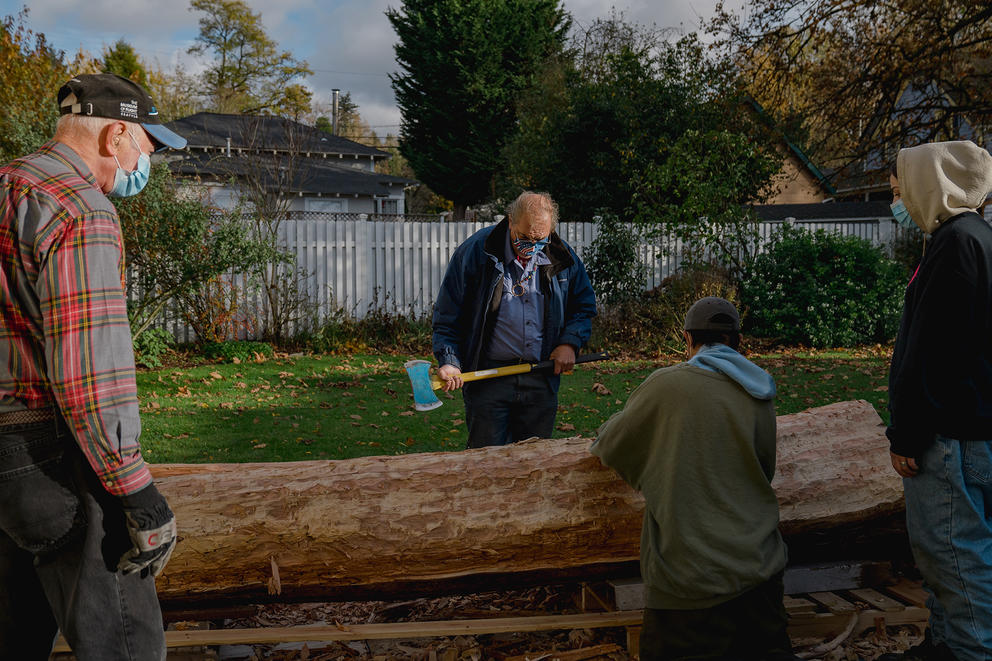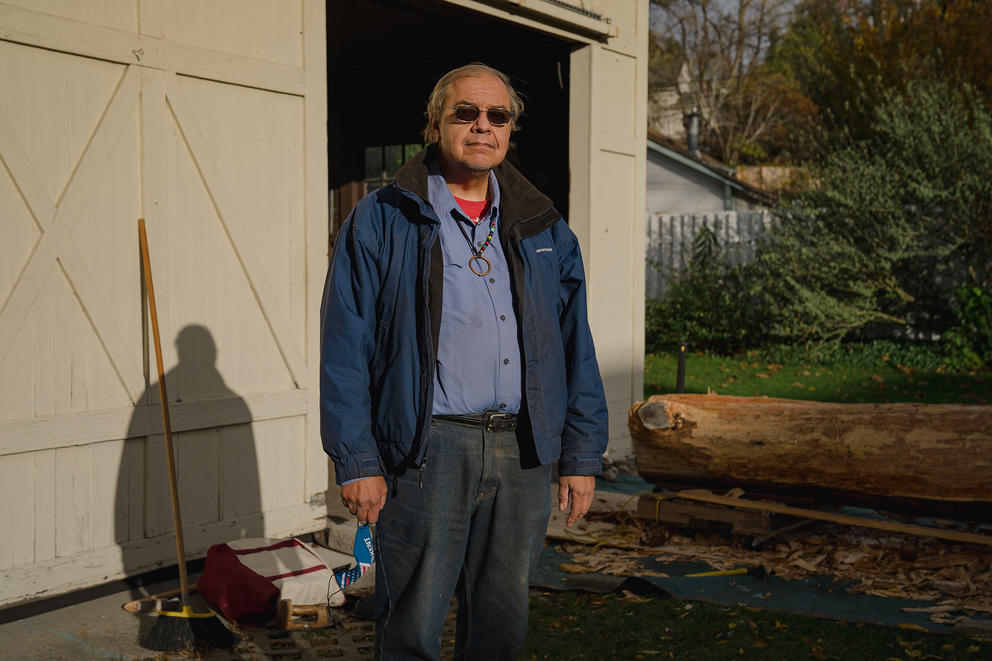A longtime fireman in Kent, Evans is also known as didahalqid**, honorable chair of the Snohomish people and mentor of the Blue Heron Canoe Family. Evans is skilled in canoe carving but this will mark his first time carving a welcome figure, a type of artwork historically made by Coast Salish tribes to greet travelers.
On this particular Friday, Evans and his apprentices are prepping a cedar log outside of the Kent Historical Museum, which commissioned the piece. After several months of whittling, this log will take form as a 6-foot-tall human figure and will eventually be installed in front of the museum. Cedar shavings litter the ground as the team removes the near-white first layer of wood to reveal a deep red underneath.
“It’s the dead part of the tree that has the preservers that keep it from rotting,” Evans says, explaining the red section. It’s why cedar art can survive all kinds of weather,” he says, “like Washington’s constant downpours.”
A tradition for Pacific Northwest Native artists, carving has changed significantly over the past centuries. Current barriers to the Coast Salish practice include logging, which has decimated the once bountiful supply of old-growth cedar. Also challenging: an art market that for a long time has prioritized Native work from more northern regions, resulting in less exposure to and understanding of localized traditions.
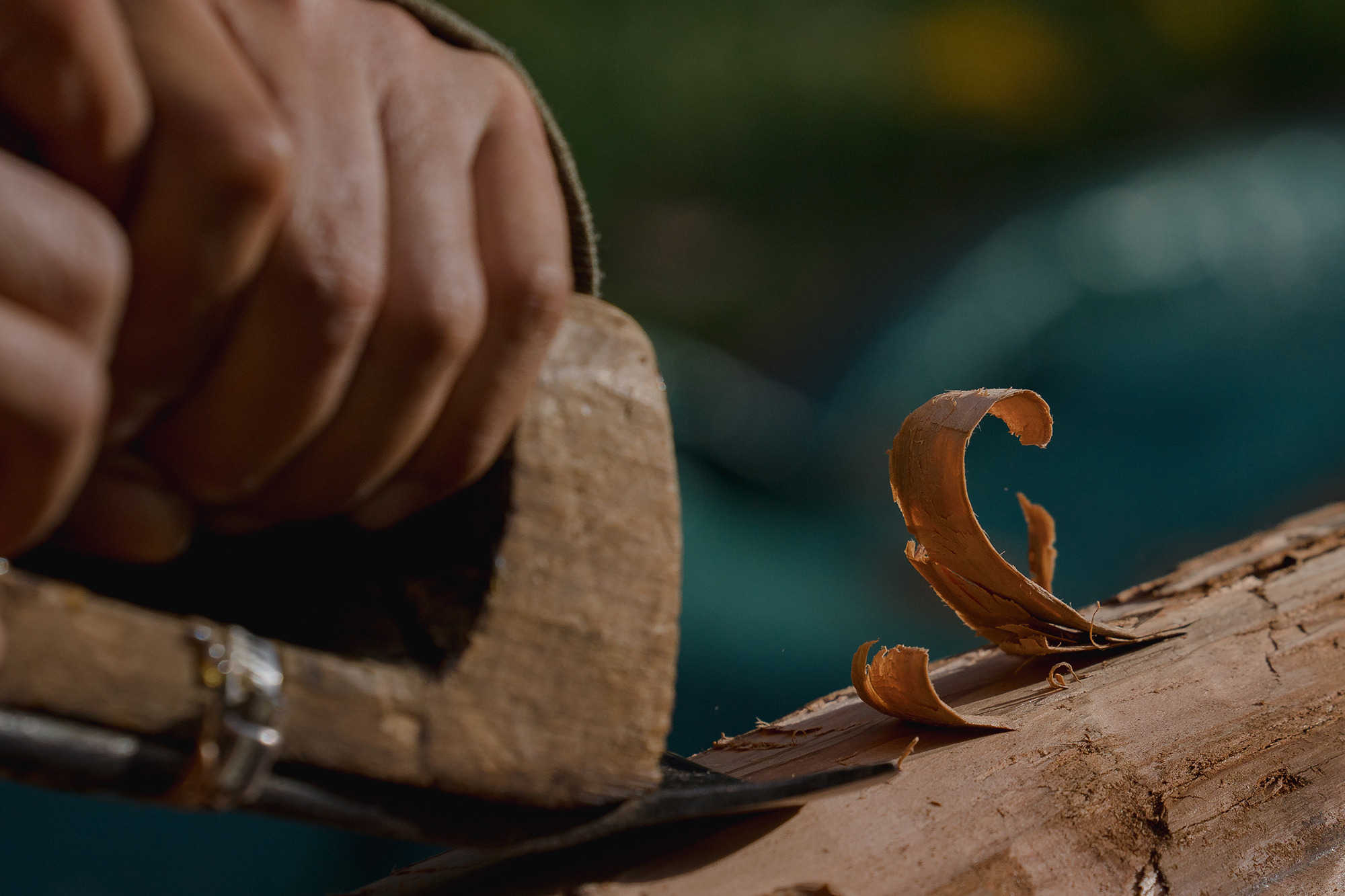
But that hasn’t stopped Native carvers from finding ways to keep the art alive. Many are driven by a desire to elevate the form, especially Columbia River and Salish art variants that have long been overlooked. And thanks to several new public art projects, such works — and their makers — are getting the spotlight they’re due.
The log Evans is working on comes from a tree that would be considered “second growth” — he guesses that it’s about 60 years old. But traditionally, Native artists in the region have worked with fallen old growth logs that can be more than a thousand years old.
These days, those are harder to come by. “You’ve got to go further away to find them,” Evans says.
Like many Native carvers, Evans says the art form is a key aspect of his cultural connection. He began carving large-scale pieces tied to his Snohomish heritage in his 40s, following a dream he’d had that reminded him of his roots. The dream came during a time in his life when he felt he was losing himself.
“It [said], ‘The old ways are good ways,’ and it said that over and over again,” he says, recounting the mantra heard in his dream. “So then I went to go look for the old ways.” Following that advice, he says, renewed him.
Misconceptions about Northwest Native art
Ask the public for an example of Northwest Native art and a large percentage of people are likely to say totem poles. The impressive carved logs have become iconic. They’re scattered across Seattle, whether towering over parks or in miniature form, as tiny trinkets in tourist shops. But they’ve also been the focal point of critique here, with some critics asking that they be taken down.
Most Native artists in Washington can tell you why: Totem poles aren’t local. They’re traditionally carved by artists farther north, such as members of Indigenous communities in Alaska or coastal British Columbia. While many totem poles have been transported to Seattle (some of them stolen), the carved-pole tradition that is more authentic to our immediate area is that of welcome figures, such as the one Evans is creating.
More generally, the artwork by communities residing within Washington is stylistically different than northern Native art. Tony [naschio]** Johnson (Chinook), a carver and chairman of the Chinook Indian Nation, describes the aesthetic of his tribe’s art as “organic geometry.”
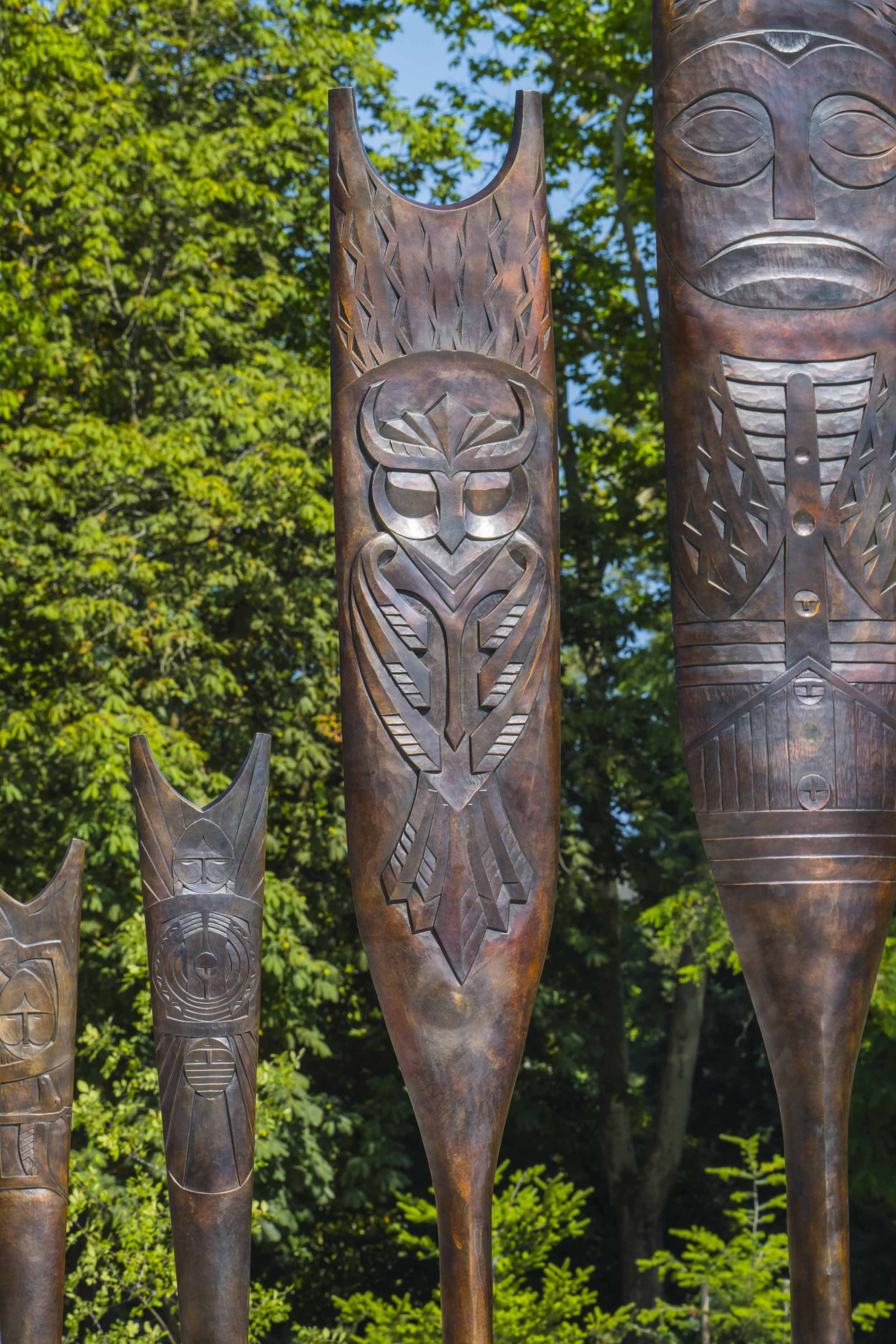
“It’s very geometric, much more so than up north, so there’s all these shapes,” Johnson says. “This art is a beautiful thing — its own thing — it encompasses our culture and sensibilities.”
Johnson admires the work of northern Native artists, but says that the public perception surrounding pieces like totem poles has overshadowed understanding of the traditional art forms of the region. He has had to make PowerPoints explaining the history of the Columbia River art aesthetic in order for it to be taken seriously.
“There’s been so much work on our part to educate people about what the art [here] actually looked like,” he says.
The fact that the Chinook aren’t federally recognized means additional barriers to understanding. Access to resources is more difficult without federal recognition, Johnson says. That, in turn, hurts the arts, and makes the tribe’s ability to pass along traditions challenging.
“We don’t have the cultural resources or programs or cultural education opportunities … like so many of the other tribes do,” he says. “Until we can do that, our teaching happens in a very different way.”
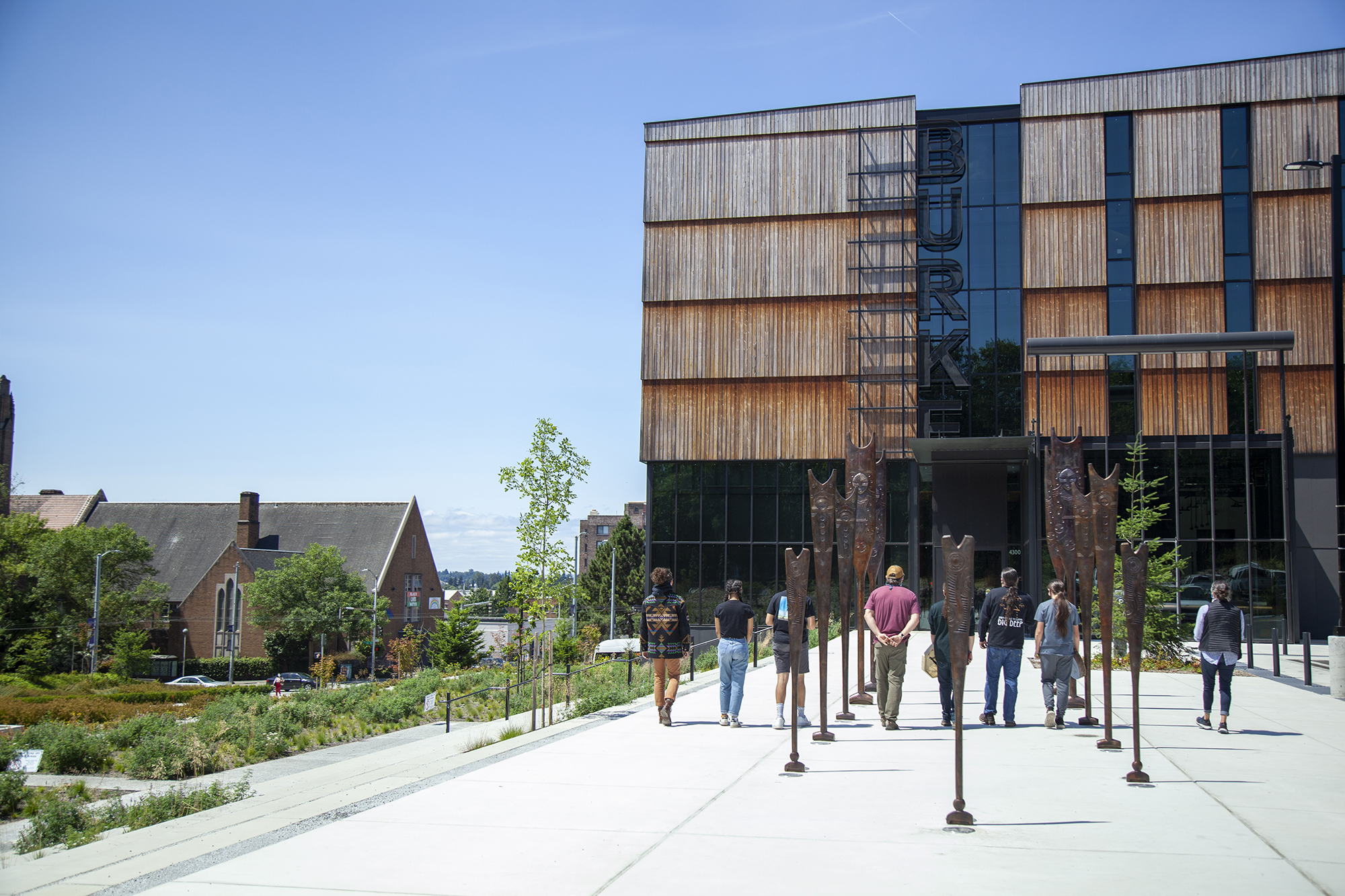
Tony A. (naschio) Johnson and artist Adam McIsaac, the piece consists of 11 large-scale bronze paddles. (Rachel Ormiston/Burke Museum)
He hopes that his most recent project will help highlight Columbia River art. Working with another local carver, Adam McIsaac, Johnson recently created “Guests from the Great River,” a series of 11 large-scale bronze paddles now on display outside the entrance of the Burke Museum.
Johnson and McIsaac first carved the paddles from Oregon ash wood. Johnson says that, like cedar, this wood is hard to come by. In fact it was difficult to find ash large enough to carve the paddles at their intended scale (11 feet tall), so the team used a new technology to scan the carved paddles, enlarge the scans, and create 3D printed molds to be cast in bronze.
The paddles stand on their ends, raised in a customary form of greeting. Each is decorated with intricate designs, animals and faces representing traditional Chinook teachings and stories. Each also has a notch at the paddle end, customarily used to grab cottonwood roots along the Columbia River. Johnson says this prominent display gives regional art “further life and currency” at a museum that’s long drawn people in with its displays of traditional Native art.
“The Burke Museum has always been an iconic place,” he says. “So the opportunity for us to do a Chinook-focused, Columbia River-focused piece ... feels like a full-circle thing.”
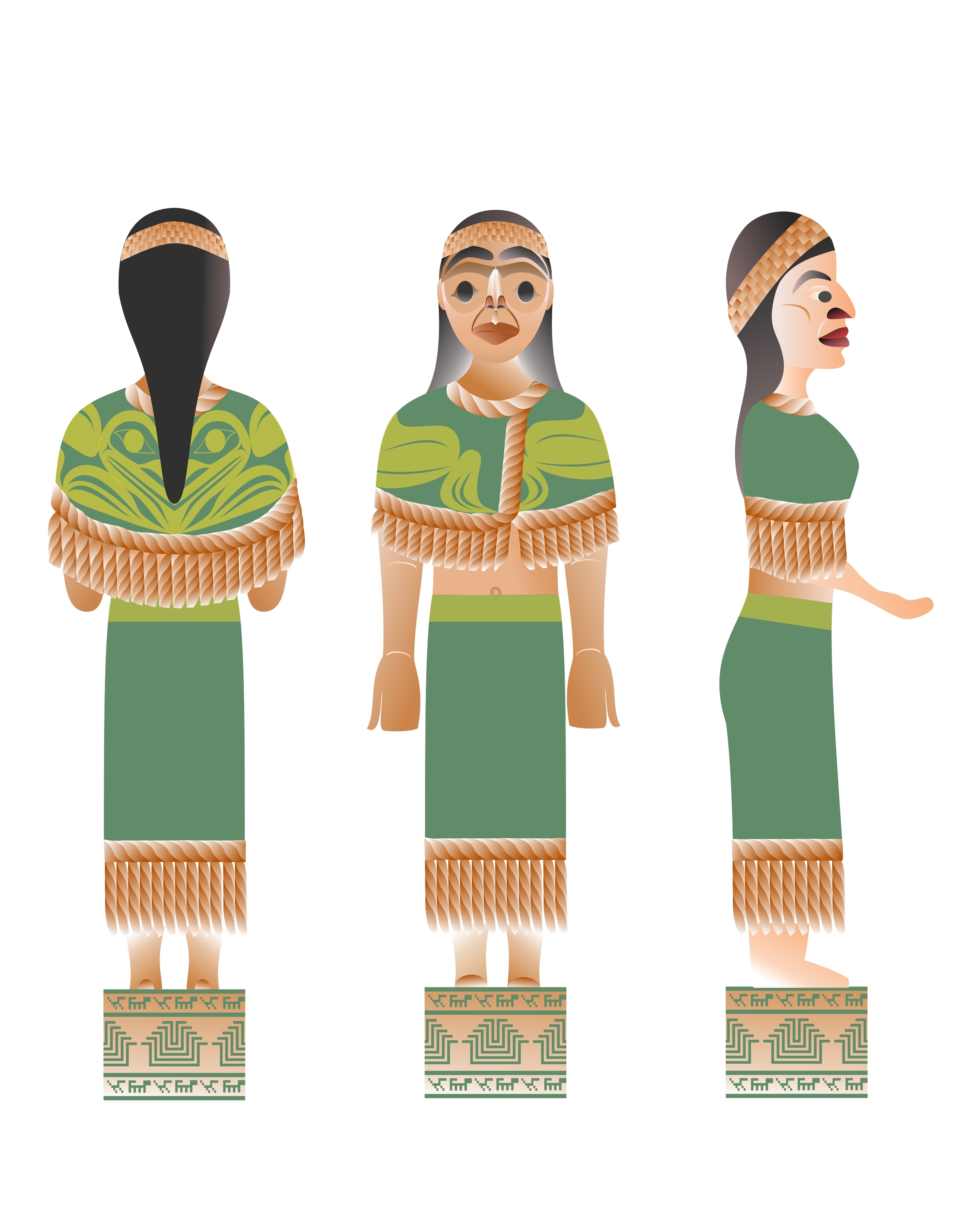
Piecing it together
Andrea Wilbur-Sigo (Squaxin Island) is also working on a piece that will give regional Native carving new prominence — the first Salish carving of its kind in downtown Seattle.
The welcome figure will stand at the entrance of the Chief Seattle Club’s forthcoming ?ál?al facility, an eight-story mixed-use building in Pioneer Square that will include affordable housing for Native Americans (due to open October 2021). Wilbur-Sigo will start carving the piece in January. When complete, it will take the form of a 25-foot-tall woman clothed in green (a color common to the natural dyes of the Pacific Northwest), her arms outstretched in greeting.
Wilbur-Sigo began making art when she was 3, starting with beadwork. As a teenager, she got into carving and became the first woman in her family’s recorded history to do so. These days, she teaches classes that have introduced younger members of her tribe to traditional art forms. She says she has always worked to represent her tribe by promoting its arts. Creating a welcome pole for a prominent public space is something she’s worked for all her life.
“It’s kind of like watching all my dreams come true,” Wilbur-Sigo says.
It’s taken persistence in the face of adversity. In past decades, Wilbur-Sigo had similar experiences to Johnson regarding which Native art forms were more “popular.” The emphasis on totem poles and related northern traditions made galleries less interested in her Coast Salish pieces. She remembers arguing with a Canadian gallery when it initially refused to represent her work, telling her it wasn’t “sellable.”
“Salish work wasn’t as accepted 25 years ago in the gallery world,” Wilbur-Sigo says.
She’s seen some positive change and better understanding of Salish art. This public welcome pole project is one step toward that. But more recently, Wilbur-Sigo has run into another current problem for contemporary carvers. No matter where she has looked, she hasn’t been able to find an ancient-growth log that’s large enough to make her figure. Instead, she’ll have to piece together two or three cedar logs to create the towering welcome pole.
Wilbur-Sigo has worked with old growth cedar before, sometimes from a tree more than a thousand years old. The best wood is ancient, she says, because tighter rings make carving more stable. But there’s no quick way to reproduce old growth once it’s destroyed, and now these fallen giants are harder than ever to find.
“My family and I have talked about [the fact that] one day, the bigger logs just aren’t going to be here,” Wilbur-Sigo says. “As years go by, you don’t think about it really happening, but it’s here. Every year, it seems to get a little more difficult.”
Technically, Wilbur-Sigo and other artists who are members of federally recognized tribes can go to a forest to get wood themselves. Her tribe’s treaty rights protect her right to collect the wood, but the process is hard work, mired in regulations and paperwork. Wilbur-Sigo hasn’t done so since a log-gathering journey she made 23 years ago with her family.
“A lot of our carvers usually just end up at the mill, buying it,” she says. “It’s one of those things we’ll continue to work on, and hopefully one day there’ll be an easier working relationship to earmark those logs.”
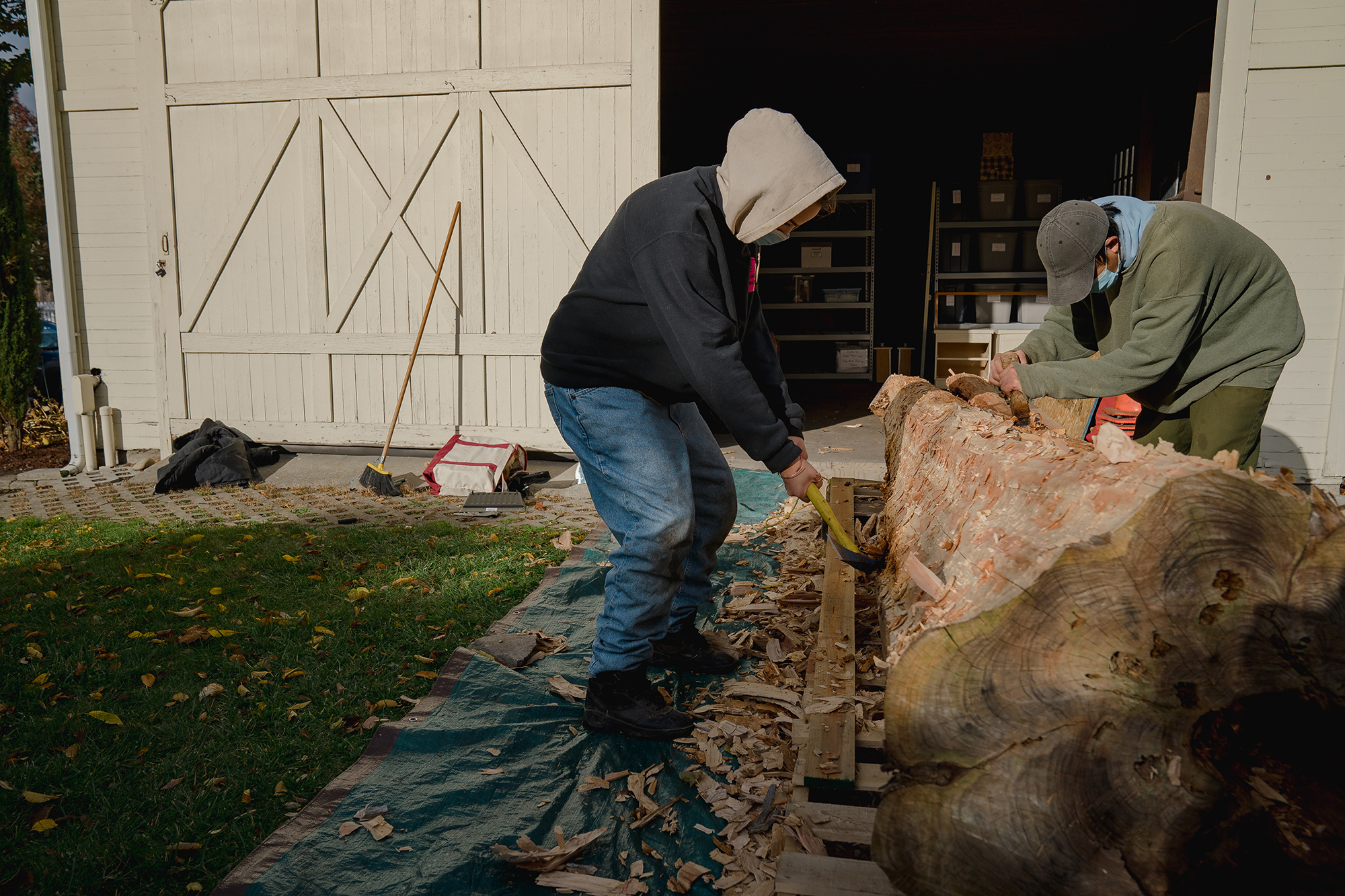
Teaching old ways to future artists
Despite the challenges in sourcing wood, Wilbur-Sigo says she would never cut down a living cedar tree for her art.
“Personally, I would never take a cedar down, nor would my kids — it’s something we don’t believe in,” Wilbur-Sigo says. “There have to be logs that decide to let my kids carve them, my grandkids carve them. It’s something we’ve always been taught.”
Her elders instilled that in her, she says, teaching her to carve only from fallen trees. In that way, she says, the trees are used only when “they’re ready to give themselves to us.”
Much of Wilbur-Sigo’s practice involves teaching future generations that will take up the craft, passing along lessons such as these. But, she adds, carving is not only taught in a class: “It’s just a part of your life.”
It’s been more than two decades since Snohomish carver Evans began his journey back to “the old ways,” taking up an art form that has also become a way of life. Now, he too is teaching younger artists about the craft and history of carving. He instructs both Native and non-Native students how to carve, often doing so by working on a canoe together to use in the annual Canoe Journey.
This year, the Canoe Journey was canceled because of the coronavirus, so Evans says he had time to approach this work in a new way, via the welcome pole in Kent. But he says his philosophy remains the same: He wants to preserve these traditions and move them into the future.
“We’re not going to be able to go back,” he says. “But we can bring certain things forward.”
*This indicates a person’s tribal affiliation.
**This indicates a person’s Native name.
Get the latest in local arts and culture
This weekly newsletter brings arts news and cultural events straight to your inbox.

